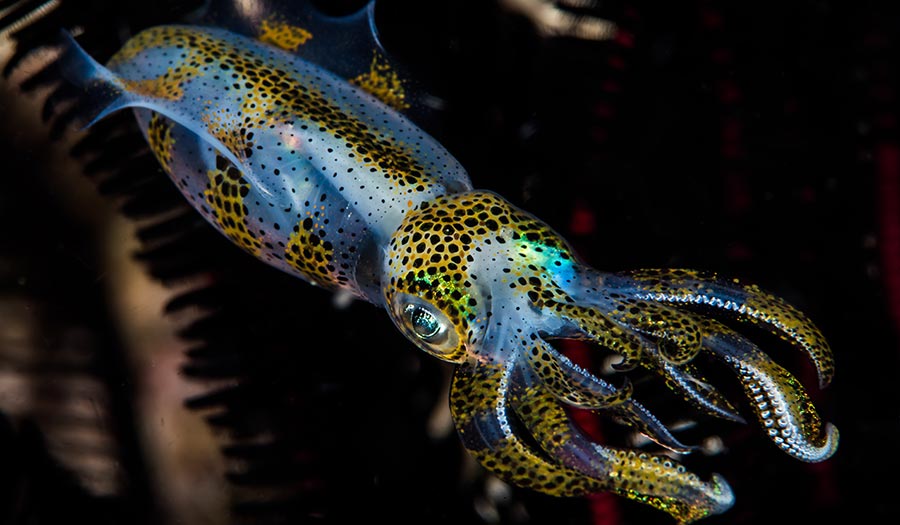 Getty Images
Getty Images
Article
Squids’ remarkable ability to tune both the color and brightness of their iridescence could hold the keys to developing coatings with tunable optical properties for soldiers.
Learn the why behind the headlines.
Subscribe to the Real Truth for FREE news and analysis.
Subscribe NowSquids have long been a source of fascination for humans, providing the stuff of legend, superstition and myth. And it is no wonder—their odd appearances and strange intelligence, their mastery of the open ocean can inspire awe in those who see them.
Legends aside, squids continue to intrigue people today—people like University of California, Santa Barbara, professor Daniel Morse—for much the same, albeit more scientific, reasons. Having evolved for hundreds of millions of years to hunt, communicate, evade predators and mate in the vast, often featureless expanses of open water, squids have developed some of the most sophisticated skin in the animal kingdom.
“For centuries, people have been amazed at the ability of squids to change the color and patterns of their skin—which they do beautifully—for camouflage and underwater communication, signaling to one another and to other species to keep away, or as attraction for mating and other kinds of signaling,” said Dr. Morse, a Distinguished Professor Emeritus of Biochemistry and Molecular Genetics.
Like their cephalopod cousins the octopus and cuttlefish, squids have specialized pigment-filled cells called chromatophores that expand to expose them to light, resulting in various shades of pigmentary color. Of particular interest to Dr. Morse, however, is the squids’ ability to shimmer and flicker, reflecting different colors and breaking light over their skin. It is an effect that is thought to mimic the dappled light of the upper ocean—the only feature in an otherwise stark seascape. By understanding how squids manage to fade themselves into even the plainest of backgrounds—or stand out—it may be possible to produce materials with the same, light tuning properties for a variety of applications.
Dr. Morse has been working to unlock the secret of squid skin for the last decade, and with support from the Army Research Office and research published in the journal Applied Physics Letters, he and co-author Esther Taxon come even closer to unraveling the complex mechanisms that underlie squid skin.
An Elegant Mechanism
“What we’ve discovered is that not only is the squid able to tune the color of the light that’s reflected, but also its brightness,” Dr. Morse said. Research had thus far has established that certain proteins called reflectins were responsible for iridescence, but the squid’s ability to tune the brightness of the reflected light was still something of a mystery, he said.
Previous research by Dr. Morse had uncovered mechanisms by light-reflecting cells in the opalescent inshore squid’s skin can take on virtually every color of the rainbow. It happens with the cell membrane, where it folds into microscopic accordion-like structures called lamellae, forming tiny grooves.
“Those tiny groove structures are like the ones we see on the engraved side of a compact disc,” Dr. Morse said. The color reflected depends on the width of the groove, which corresponds to certain light wavelengths. In the squid’s light-reflecting cells, these lamellae have the added feature of being able to shapeshift, widening and narrowing.
Light at the Speed of Thought
It all starts with a signal, a neuronal pulse from the squid’s brain.
“Reflectins are normally very strongly positively charged,” Dr. Morse said of the iridescent proteins, which, when not activated, look like a string of beads. Their same charge means they repel each other.
But that can change when a neural signal causes the reflectins to bind negatively charged phosphate groups that neutralize the positive charge. Without the repulsion keeping the proteins in their disordered state, they fold and attract each other, accumulating into fewer, larger aggregations in the lamellae.
These aggregations exert pressure on the lamellae, releasing water outside the cell.
“Water gets squished out of the accordion-like structure, and that collapses the accordion so the thickness in spacing between the folds gets reduced, and that’s like bringing the grooves of a compact disc closer together,” Dr. Morse explained. “So the light that’s reflected can shift progressively from red to green to blue.”
At the same time, the membrane’s collapse concentrates the reflectins, amplifying brightness.
“It’s a very clever, indirect way of changing color and brightness,” Dr. Morse said.
Designing “Tunable” Materials
The presence of a membrane may be the vital link for the development of bio-inspired thin films.
“This discovery of the key role the membrane plays in tuning the brightness…has intriguing implications for the design of future…materials and coatings with tunable optical properties that could protect soldiers and their equipment,” said Stephanie McElhinny, a program manager at the the Army Research Office, an element of the U.S. Army Combat Capabilities Development Command’s Army Research Laboratory.
Dr. Morse is collaborating with engineering colleagues to investigate the potential for a more squid skin-like thin-film. “If we want to capture the power of the biological, we have to include some kind of membrane-like enclosure to allow reversible tuning of the brightness.”
- Real Truth Magazine Articles
- SCIENCE & TECHNOLOGY
 Copying the Genius in Nature – What Biomimicry Reveals
Copying the Genius in Nature – What Biomimicry Reveals


